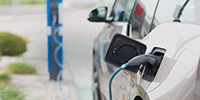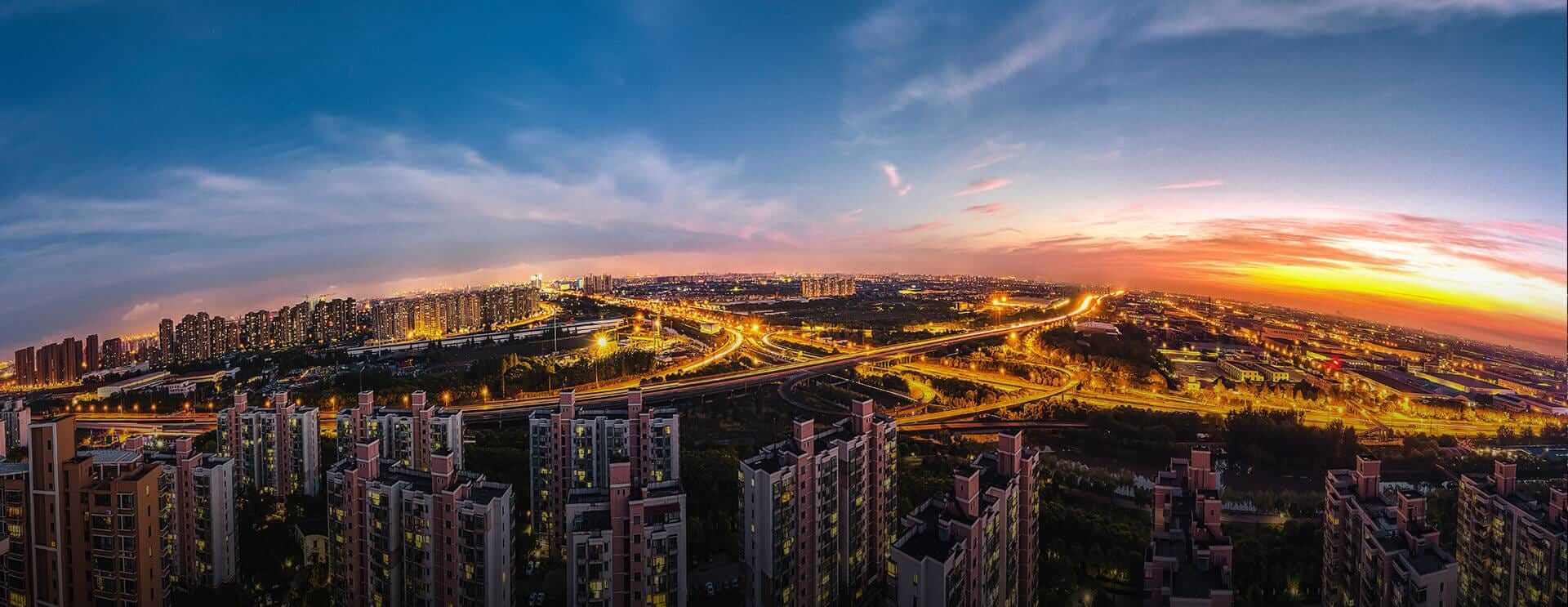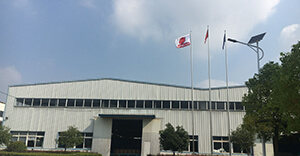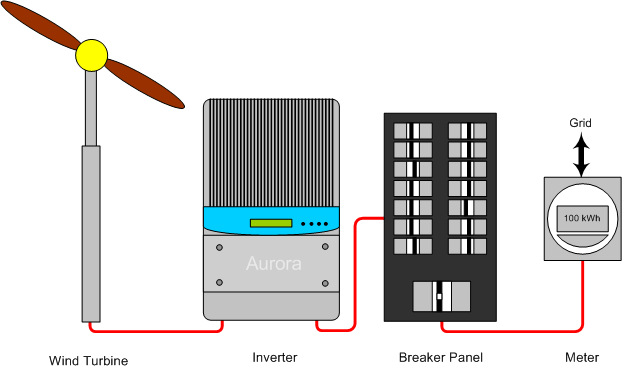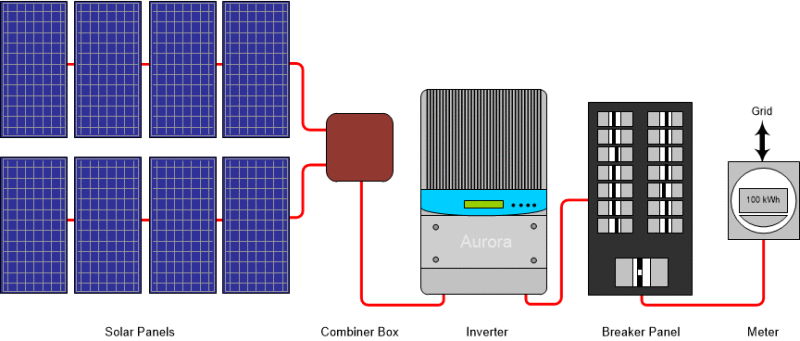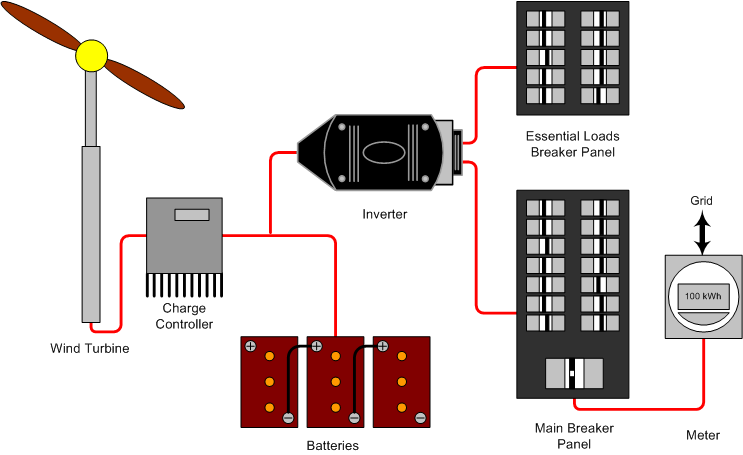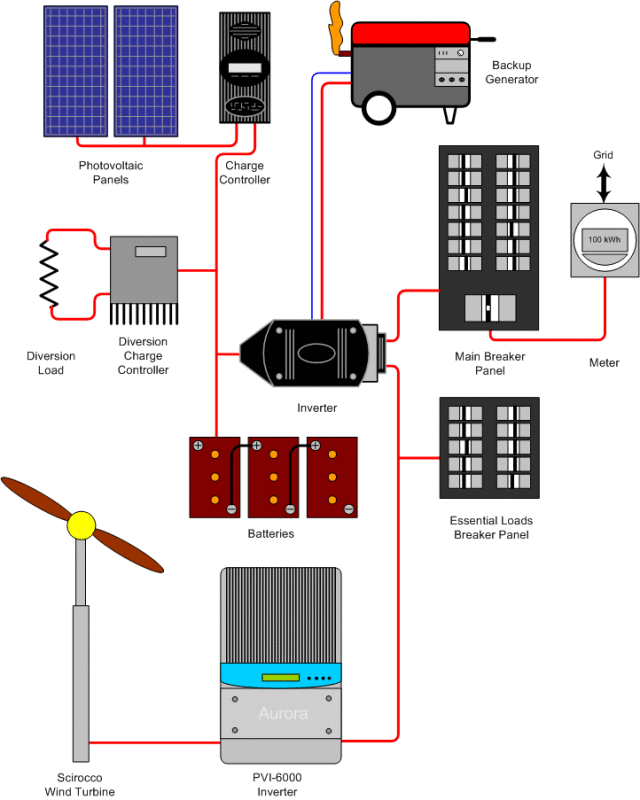When green energy and electrical connections will be amazing
|
So you are producing energy with a windmill or solar panels, now how can you use this to power your light bulbs? The technology behind renewable energy systems is confusing for those new to the field. Your renewable energy sources can be grid-connected, or off-grid, with battery backup in case the grid goes out, or without, and that is just the beginning. This section intends to give an overview of the basics involved in connecting renewable energy sources together, and to the grid. There are several sections that are increasingly more complex: Grid Connected Wind & Solar Power – The Easy WayThe simplest way to hook up a wind generator is directly to the grid, without batteries. All that takes is the proper inverter: This drawing leaves out a few details, such as surge protection, turbine breakers, and disconnects, but the essentials are all there. The wind causes the blades to spin, the blades turn the alternator in the windmill, and it produces electricity. Depending on the wind turbine it is either AC or DC. Since most small wind turbines use permanent-magnet alternators, what comes out is something called ‘3-phase wild AC’. This is because it uses three wires, and both the voltage and frequency of the electricity produced by the alternator vary with the wind and rotor RPM. We cannot dump this wild AC directly onto the grid, the electricity company would be very unhappy if you did, we need an inverter. The inverter takes care of turning that wild AC into the neatly organized form of AC that is used by the electrical grid, matching its voltage, frequency, and phase exactly. From the inverter the power feeds through a breaker into your breaker panel, the part will go towards providing electricity for your house, and if there is anything left over it will go out through your meter to the electrical grid (and the meter would spin backward in that case). The same works for solar too: Just substitute solar panels instead of the wind turbine. Multiple solar panels connect together to form a ‘string’ of panels, and multiple strings connect together (either in a combiner box or directly in the inverter). The solar panels produce DC electricity, and the inverter takes care of running those solar panels just right so they delivery maximum power for all the different lighting conditions, while creating grid-compatible AC out of this. Now, the inverters used to grid-tie a wind turbine are very different beasts from those used to grid-tie solar panels. While some people use solar PV inverters to couple a wind turbine to the grid this is bound to result in disappointing results. Wind turbines are Voltage sources, while solar panels are current sources. Both have a very different way they are used optimally, called Maximum Power Point Tracking (MPPT), and a wind inverter does MPPT very different from a solar inverter. This setup is often used for net-metering. On the very windy days when your wind turbine produces more than you need it will push the excess power onto the grid (to be used by your neighbors and such), while on the days with little wind you will be using power from the grid, together with what your wind generator produces. Once a year the power company takes a look at your meter, subtracts power you pushed onto the grid from the amount you used from the grid, and charges you for the difference. If you produced more than you used they will thank you, but they will not pay you for the excess power. The advantage of this setup is that it is the cheapest way to connect a wind turbine or solar panels to the grid. The disadvantage is that if grid power goes out, your house will be without power too, even if this happens during a raging storm (as it usually does) while your wind generator is producing oodles of energy. The inverter will sense when the grid goes out, and it will stop supplying power. This is to protect any linemen working on the wires down the road from getting electrocuted by your inverter. The rules for this are very strict, and that is why power companies require that the inverter is UL1741 or CSA 22.2 listed. Battery Backup – Keeping The Lights On When The Grid Goes OutSo what if you do not want the lights to go out when the grid does? That can be done too, the setup gets a little bit more complicated and you will need batteries: In this setup, the power produced by the wind generator is used by a charge controller for charging a set of batteries, or if the batteries are full then power will go straight to the inverter. The charge controller takes care of converting the unregulated wind electricity into something the batteries like, and just as important, it protects the batteries from various conditions such as overcharging and excessive current. The inverter in this configuration is different from the simpler case (without batteries), and a little bit more sophisticated. It takes battery or charge controller power and converts this to grid power that goes towards powering household loads. If there’s more power than needed, the excess will go out to the grid, just as before, spinning the meter backward in the process. The inverter also takes care of charging the batteries if needed, using grid power. Of course, you want the wind generator to keep the batteries charged, but it is good to know that when needed the inverter can do the job too so battery life will not suffer. Things get more interesting when grid power goes out. The inverter has a switch built into it, and as soon as it senses the grid is gone it very quickly throws that switch. It will continue to convert battery power to grid power, but now only the second breaker panel with essential household loads will receive power. The main breaker panel will be without power, just as before, so any linemen working down the road will not get electrocuted. Switching over is so fast, in a matter of milliseconds, that you will likely not even notice. Power will now be provided by the batteries and wind turbines. When the inverter senses the grid is alive again, it will sync up its output with the grid, and throw the switch once again, restoring things back to normal. loads of your house are separated out into two groups, essential and non-essential loads. Essential loads would be things like your furnace, water pump (if you are on a well), some lights, the home theater (losing power is one thing, not being able to watch your movie is a whole other thing!) etc. The main breaker panel will contain everything else, including loads that are simply too large to power through the inverter, such as an electric range, air conditioning etc. Only the panel with essential loads will receive power when the grid is not working. Of course, if grid power is available both panels have power. Inverters and battery banks can be made very large, so if you really want to, and do not mind spending the money, it is entirely possible to do away with the main breaker panel, or rather, the panel with essential loads will become your main (and only) breaker panel. This setup has the substantial advantage that at least some loads in the house will continue to have power, even if the grid does not. The downside is that it is more complicated, with the addition of a charge controller and batteries, and more expensive. In particular, it would be very, very expensive to have sufficient batteries to power the average Canadian house (at around 30 kWh a day) to bridge a few days a year when power is out. That is why you want to split out essential loads, and only power those using battery power, resulting in smaller and cheaper batteries. The configuration in the previous figure can also be used to power a house or cottage that is completely off-grid. Just leave out the extra panel and grid connection in this setup. Some inverters can be used for both grid-connected and off-grid use, others are specific for one or the other. In any event, with the right inverter, it can be done just fine. Combining A Wind Turbine, Solar PV, and a Generator – Living in the Lap of Renewable LuxuryThe final setup to be discussed here is “the works”, where wind and solar power are combined, with battery backup, and with a backup generator to charge the batteries if power runs low during those dark winter days after an ice-storm: This is pretty much the non-plus-ultra of a renewable energy grid-connected setup. This example uses a grid-tie wind turbine because we want to show how batteries are charged with it. There is no direct battery charge controller for a grid-tie wind turbine. That means we have to grab into the bag of tricks to combine it with batteries, that is no problem though! What the line diagram shows is how a regular MPPT inverter, an Aurora from Power-One, to back-feed the inverter (either an Outback, Magnum, Xantrex/Conext or SunnyIsland inverter). This works great: All the energy that is not used directly by the essential load's panel is fed into the batteries. What it does not do is keep the batteries from overcharging. That is why there is a separate charge controller, used in diversion mode. It makes sure the batteries are kept in optimal shape. The diversion load could, for example, be used to heat water with excess energy. Using a grid-tie inverter in combination with a battery-based off-grid inverter is called “AC-coupling”. It allows for the interconnection of equipment that does not have a charge controller, only a grid-tie inverter. It does have its own set of special requirements, and when planned correctly it can work very well! The solar panels have their own charge controller to charge the batteries when the sun shines (though the diversion controller could take care of that too if it’s sized sufficiently large). Combining wind and solar makes a whole lot of sense; they enhance each other wonderfully. When the sun shines there is often little wind, while on the dark days without much sun it tends to be windy. If the grid goes down the batteries take care of running the essential household loads. Finally, when those batteries run low, the inverter can start a backup generator (the blue line in the drawing is meant to symbolize the control connection to do this, while the red lines are power cables). Once the batteries are full again the inverter can even shut off the generator. Excess energy from sun or wind can be sold back to the grid, for use with net-metering. Augmenting renewable energy set up with a (non-renewable) gasoline, diesel, or natural/propane gas generator works very well; It allows for the battery bank and renewable energy sources to be much smaller than they would have to be without the generator and is therefore much more affordable. Since the generator is not running all the time when grid power is out, most of the time the batteries, silently and cleanly, provide energy to power the house. When the generator runs it is used at close to capacity, which is much more efficient, using less fuel and producing less pollution, vs. running with a small load. This same setup can also be used for off-grid power. Simply remove one of the power panels and the grid connection. The correct choice of the inverter will then generate 120/240 Volts from all the energy sources available to power the house. Of course, endless variations of the above setup can be made: With or without solar power, generator, or wind. The options are only limited by your wishes (and budget)! Wisdom Power® is a manufacturing and trading combo, specialized in sealed lead acid batteries for over 36 years. Can provide CE, ISO9001, UL, UN38.3 and test report to our clients. |





